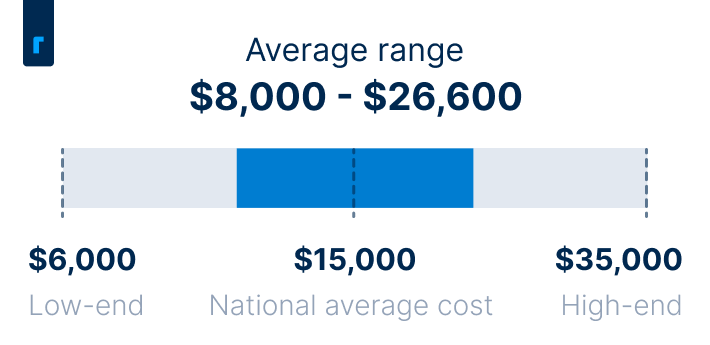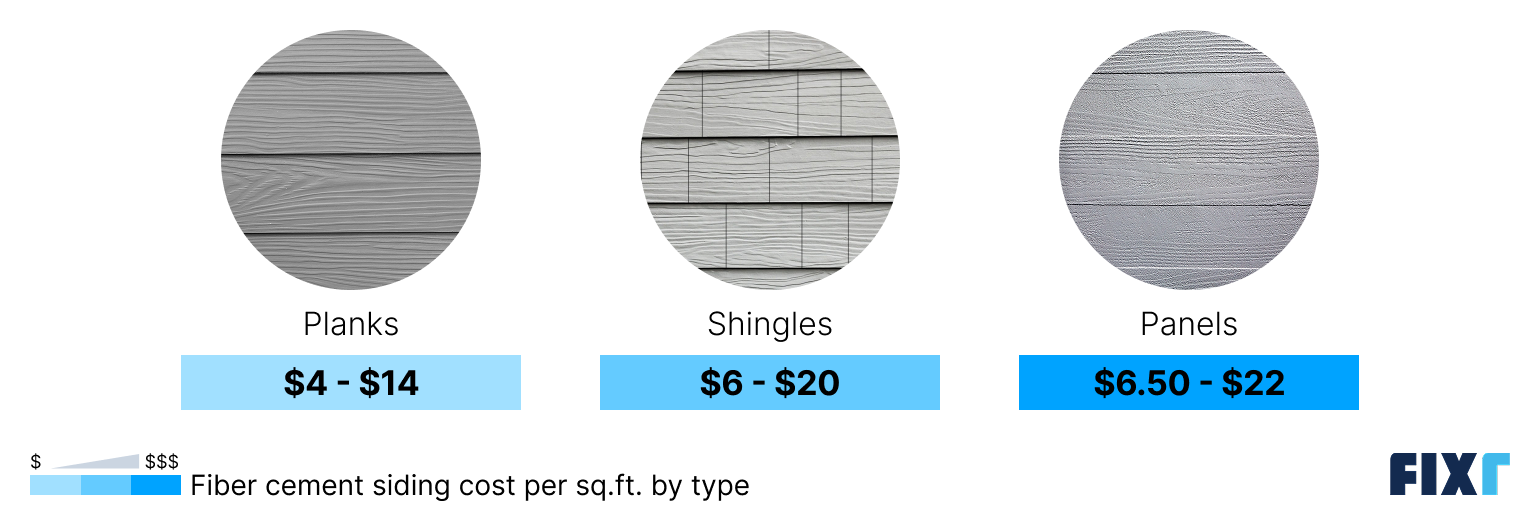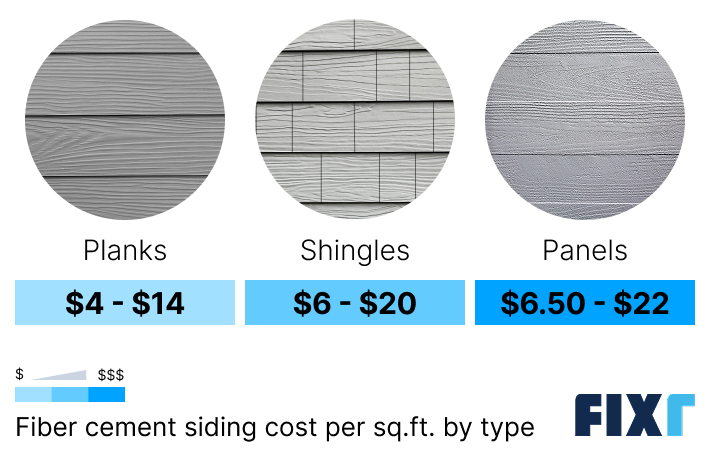Updated: November 14, 2025
Written by Dan Simms
Nieves is a home remodeling editor at Fixr.com with special interest in landscaping, pest control, painting, installation, and repair projects. She brings her work ethic, creativity, and love for teamwork into everything she does, including working with writers and designers at Fixr.com to develop useful and comprehensive guides for homeowners.
Learn moreReviewed by Nieves Martinez
Fiber cement siding is a more durable option than vinyl, which is still the most prevalent siding material in the U.S. Fiber cement is made from Portland cement, sand, water, and wood fibers, and that composition means a longer lifespan and superior resistance to damage from extreme weather. Many homeowners also prefer the look over traditional vinyl, so upgrading boosts curb appeal and home value, in most cases.
The average cost to install fiber cement siding is $15,000, and most homeowners pay somewhere between $8,000 and $26,600. Your costs will depend on home size, home design, the style or type of fiber cement siding you want, local labor costs, and more.
Cost of Fiber Cement Siding


The terms “fiber cement siding” and “Hardie plank siding” are often used interchangeably. Hardie plank, made by JamesHardie, is a brand of fiber cement siding.
Fiber Cement Siding Cost Factors
Some homeowners pay as little as $6,000 to install fiber cement siding on their homes, but prices can climb as high as $35,000. There’s such a wide range because there are a few factors that can dramatically affect pricing.
House Size
On average, fiber cement siding costs per square foot range from $5 to $14 on average, and since many siding contractors base their costs on square footage, the size of your home and how much siding you need are some of the most important cost factors to consider.
You can use the table below to get an idea of your costs based on your home’s exterior square footage.
Home Size (Square Feet) | Average Siding Needed (Square Feet) | Average Cost Range |
1,000 | 1,200 – 1,300 | $6,000 – $18,200 |
1,200 | 1,400 – 1,600 | $7,000 – $22,400 |
1,500 | 1,600 – 1,800 | $8,000 – $25,200 |
1,850 | 1,700 – 1,900 | $8,500 – $26,600 |
2,000 | 1,800 – 2,000 | $9,000 – $28,000 |
2,500 | 2,000 – 2,200 | $10,000 – $30,800 |
3,000 | 2,300 – 2,500 | $11,500 – $35,000 |
Fiber Cement Siding Cost by Type
Fiber cement is made to resemble wood, and it comes in similar styles to wood siding, including planks, shingles, and panels for board and batten siding.
Fiber cement siding planks: Planks are the most common style, as they resemble traditional vinyl siding. They’re long and thin and usually lay horizontally on your home. Planks are the easiest to install and come with the lowest costs.
Fiber cement siding shingles: Shingles are much smaller pieces that overlap to give your siding texture and depth. Shingles are more expensive to install because each piece needs to be nailed individually.
Fiber cement siding panels: Fiber cement panels are used to create a board and batten design, with long, wide, vertical planks that have a thinner strip dividing them. Fiber cement board and batten siding costs the most to install because each piece is heavy and requires multiple laborers to maneuver it into place.


Siding Type | Cost per Square Foot |
Planks | $4 – $14 |
Shingles | $6 – $20 |
Panels | $6.50 – $22 |
Labor
Labor will account for between 40% and 60% of your total fiber cement siding installation costs. Some siding professionals charge by time, in which case you’re looking at between $40 and $90 per hour. Others will charge by the square foot, in which case you’d pay between $2 and $8 per square foot.
Since labor is such a big part of your total, anything that makes the job take longer will drive your fiber cement siding prices higher. This includes a complex home design, multiple floors that require ladders or scaffolding, and unexpected repairs to the materials behind your old siding.
Location
Where you live plays a role in both your material and labor costs. Fiber cement is growing rapidly in popularity, but it may not be as widely available in some areas, which means higher shipping costs for materials. Labor costs also fluctuate based on the local cost of living, so you should expect to pay above-average costs if you live in or near a major city, or if you live in a more expensive state, like New York or California.
Additional Costs and Considerations
There are some other factors you should consider to get the most accurate estimate possible. While these typically don’t impact the total costs as much as home size or siding style, they can add up.
Existing siding removal and disposal: Removing your old siding and hauling away the debris will cost between $1,000 and $2,500, depending on your home size and the type of siding you’re removing. Some siding contractors include this cost in their initial estimate, so you may not need to budget separately.
Substrate repairs: Your contractor may uncover hidden issues like water damage, dry rot, or mold growth once the old siding comes off. Repairs can cost just a few hundred dollars, or they can add thousands to your total, depending on the extent of the damage.
Permit fees: Most municipalities require permits for siding replacement, which can add between $150 and $1,500.
Home design and number of stories: More complex home designs or multi-story layouts take longer to side and increase labor costs. Expect to pay more if your home has multiple bump-outs, dormers, lots of windows and doors, or requires crews to work on ladders or scaffolding.
Maintenance: Fiber cement siding is low-maintenance, but you should still plan for occasional cleaning and repairs. Pressure washing every year or two helps keep it in good condition, and minor repairs typically cost $2 to $20 per square foot, depending on the extent of the damage.
Color options: Fiber cement siding is available as primed or pre-painted materials, and you can also purchase siding that’s dyed for a longer-lasting color. Primed boards cost the least, while dyed siding is the most expensive but offers the longest-lasting finish.
Fiber Cement Siding Pros and Cons
It’s a good idea to consider the benefits and drawbacks of fiber cement siding before deciding if it’s the right material for your home. Here are some of the key things to keep in mind before you settle on this option.
Pros
- + Lasts 50+ years with proper maintenance
- + Performs well in extreme weather, including heavy impact, rain, and snow
- + Class A fire resistance for added home protection
- + Offers an attractive, high-end look that boosts curb appeal
Cons
- - Higher upfront cost than vinyl and other budget materials
- - Not recyclable, despite being made from sustainable base materials
- - Heavier material that may require additional structural support
DIY vs. Professional Fiber Cement Siding Installation
DIY siding installation is technically possible, but it’s never a good idea, especially with fiber cement siding. Fiber cement is heavier than vinyl, which means it’s harder to maneuver into place, especially on upper floors.
Even if you are comfortable with DIYing from a safety perspective, it’s still best to hire a pro. Siding is your home’s first line of defense against the elements, so it’s crucial to get everything right. Even minor mistakes can cause major problems, including water damage, wood rot, mold growth, pest infestation, and structural damage. Hiring a pro is expensive, but it’s always worth it in the long run for the peace of mind and lower risk of property damage.
Repair vs. Replacement
One of the first things you should consider when thinking about siding replacement is whether or not a repair would be a suitable option. Siding repairs cost between $2 and $20 per square foot, while fiber cement siding replacement costs an average of $5 to $14 per square foot. Even though the repair cost per square foot can be higher, a repair is usually far more affordable overall because you’re fixing a small section rather than replacing the entire exterior.
However, there are some cases in which total replacement makes more sense. If you know your old siding is reaching the end of its useful life, if it has given you ongoing problems with leaks, or if it's detracting from your home’s curb appeal and overall aesthetic appeal, replacement might be a better option in the long run. It will cost more but usually boosts home value, improves your home’s energy efficiency, and reduces the risk of expensive property damage.
Fiber Cement Siding Cost vs. Other Materials
Fiber cement siding is becoming more and more popular because it offers a premium look and strong performance without the premium cost of materials like brick or stone. It’s more durable and longer-lasting than vinyl or engineered wood, and it stands up to extreme weather better than stucco. With its long lifespan and attractive appearance, fiber cement delivers excellent value while boosting curb appeal and home resale potential.
Siding Material | Cost per Square Foot |
Engineered wood | $2 – $10 |
$3 – $12 | |
Fiber cement | $5 – $14 |
$7 – $17 | |
$8 – $21 | |
$20 – $45 |
You can check out our general siding replacement cost guide to compare the cost of different siding materials if fiber cement doesn’t seem ideal for your home.
Is Fiber Cement Siding a Good Investment?
Fiber cement siding is an outstanding home improvement investment, especially compared to most other types of siding. Not only is it one of the most durable and weather-resistant siding options, but it looks beautiful and provides a higher return on investment (ROI) than other materials, too, thanks to its long lifespan. According to the Cost vs. Value report, fiber cement siding provides a 114% ROI, even higher than more affordable vinyl, which comes with a 97% ROI.
How to Save Money on Fiber Cement Siding Costs
One of the most significant downsides to fiber cement siding is the upfront cost, as it’s more expensive than traditional vinyl siding. Luckily, there are some tips to help keep costs to a minimum:
Finish your siding yourself: You can save on material costs by purchasing primed fiber cement siding, and you can save further on labor by painting it yourself.
Choose a more affordable style: Fiber cement planks are the most affordable style, so choosing this over shingles or board and batten siding can save you thousands.
DIY the siding removal: If you’re comfortable with it, consider removing your old siding yourself and hauling it away. Just be sure to coordinate closely with your pro so that your home doesn’t sit unprotected.
Get multiple quotes: Get at least three estimates for siding replacement costs and compare them to find the best value for your money.
Aim for the off-season: Siding professionals are usually busiest in the fall, so waiting for the spring could lead to savings on labor costs due to lower demand.
FAQs
The biggest downside to fiber cement siding is the upfront cost, as you’ll pay more compared to more traditional vinyl siding. Fiber cement siding is also much heavier than many other siding materials, so you may need structural reinforcements before you can safely install it.
Yes, fiber cement siding is very often worth the investment. It costs more than vinyl siding and some other materials, but it boasts a long lifespan of 50+ years, it looks beautiful and adds significantly to your curb appeal and home value, and it stands up very well to intense weather, including hurricanes, tropical storms, and tornadoes.
On average, you should paint your fiber cement siding every 10 to 15 years, with touch-ups in between as needed. In areas with intense sunlight or severe weather, you’re more likely to need a paint job every 5 to 10 years, while homes in moderate climates with average sun exposure may need repainting every 10 to 15 years.
Fiber cement siding lasts for 50 or more years, in most cases, and some homeowners can see lifespans of up to 100 years. You’ll see longer lifespans if you live in a moderate climate with limited severe weather, and you can extend the life of your fiber cement siding by staying ahead of siding repairs and catching issues early with routine siding inspections.
Yes, fiber cement siding will increase your property value, as it provides an average ROI of 114%. That means the average homeowner will see a $17,100 increase in resale value when they install fiber cement siding. ROI can be even higher in areas that see extreme weather, as fiber cement siding is highly durable.
